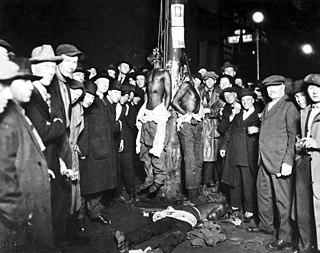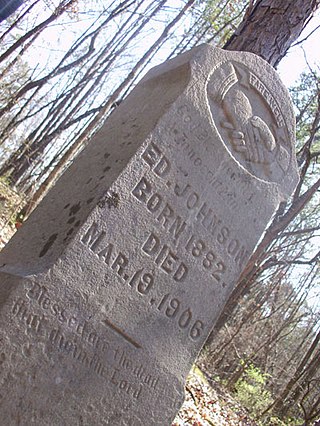Related Research Articles

On June 15, 1920, three African-American (Black) circus workers, Elias Clayton, Elmer Jackson, and Isaac McGhie, suspects in an assault case, were taken from the jail and lynched by a White mob of thousands in Duluth, Minnesota. Rumors had circulated that six Black men had raped and robbed a nineteen-year-old White woman. A physician who examined her found no physical evidence of rape.

On March 19, 1906, Ed Johnson, a young African American man, was murdered by a lynch mob in his home town of Chattanooga, Tennessee. He had been sentenced to death for the rape of Nevada Taylor, but Justice John Marshall Harlan of the United States Supreme Court had issued a stay of execution. To prevent delay or avoidance of execution, a mob broke into the jail where Johnson was held, and abducted and lynched him from the Walnut Street Bridge.

In Forsyth County, Georgia, in September 1912, two separate alleged attacks on white women in the Cumming area resulted in black men being accused as suspects. First, a white woman reportedly awoke to find a black man in her bedroom; then days later, a teenage white woman was beaten and raped, later dying of her injuries.
On February 9, 1893, Alfred Blount, an African American and a Chattanooga native, was taken from his jail cell in the county jail and brutally beaten, stabbed, and hanged from the Walnut Street Bridge in Chattanooga, Tennessee. Blount was charged with assault of a woman by the name of Mrs. M. A. Moore. Moore, 51 and widowed, claimed she was cleaning her house when a man entered through her back door requesting food. Moore, assuming it was a neighbor of hers, invited the man in and called out to her African-American house boy Sam to bring the man some food. Upon realizing Sam's absence, Moore herself went into the kitchen to prepare food before reporting being grabbed by the arm and attacked by the man. After hitting the man with her hand, Moore fainted and laid unconscious in her house before recalling the incident to her neighbor, Mrs. DeRochement.

The following events occurred in July 1903:
Ephraim Grizzard and Henry Grizzard were African-American brothers who were lynched in Middle Tennessee in April 1892 as suspects in the assaults on two white sisters. Henry Grizzard was hanged by a white mob on April 24 near the house of the young women in Goodlettsville, Tennessee.
Samuel Smith was a 15-year-old African-American youth who was lynched by a white mob, hanged and shot in Nolensville, Tennessee, on December 15, 1924. No one was ever convicted of the lynching.
David Jones was an African-American man who was lynched in Nashville, Tennessee on March 25, 1872 after being arrested as a suspect in a killing. He was mortally wounded while in jail, shot twice in the back while resisting white mob members who came to take him out; the whites pulled him into the Public Square and hanged him from a post outside the police station, with a crowd of an estimated 2,000 in attendance. The sheriff interrupted the hanging and took Jones down. Taken back to the jail, Jones died of his injuries on April 9, 1872.
Jim Taylor was an African-American man who was lynched on April 30, 1891 in Franklin, Tennessee.

Amos Miller was a 23-year-old African-American man who was lynched from the balcony of the Williamson County Courthouse in Franklin, Tennessee, on August 10, 1888.
Jo Reed was an African American man who was lynched in Nashville, Tennessee, on April 30, 1875, where he was taken by a white mob from the county jail after being arrested for killing a police officer in a confrontation. He was hanged from a suspension bridge but, after the rope broke, Reed survived the attempted lynching, escaped via the river, and left Nashville to go West.

Alonzo Tucker was an African American boxer and owned a gym in Coos Bay, Oregon. He was accused by Mrs. Dennis for assault. After the lynching, Dennis and her family quickly left town and headed to California. Tucker is the only documented lynching of a black man in Oregon.
Winston Pounds was an African-American man who was lynched by a mob in Wilmot, Arkansas, on August 25 or 26, 1927.
The Danville race riot occurred on July 25, 1903, in Danville, Illinois, when a mob sought to lynch a Black man who had been arrested. On their way to county jail, an altercation occurred that led to the death of a rioter and the subsequent lynching of another Black man. At least two other Black residents were also assaulted. The rioters failed to overtake the police stationed at the jail and the Illinois National Guard restored order the next day.
The lynching of F. W. Stewart occurred shortly after midnight on November 7, 1898, about a mile outside of Lacon, Illinois. Stewart had been accused of the assault of a miner's daughter in Toluca. About one hundred miners formed a mob and broke into the Marshall County jail to retrieve Stewart, whom they hanged.

A mob of white Vigo County, Indiana residents lynched George Ward, a black man, on February 26, 1901 in Terre Haute, Indiana, for the suspected murder of a white woman. An example of a spectacle lynching, the event was public in nature and drew a crowd of over 1,000 white participants. Ward was dragged from a jail cell in broad daylight, struck in the back of the head with a sledgehammer, hanged from a bridge, and burned. His toes and the hobnails from his boots were collected as souvenirs. A grand jury was convened but no one was ever charged with the murder of Ward. It is the only known lynching in Vigo County. The lynching was memorialized 120 years later with a historical marker and ceremony.

On October 11, 1878, Jim Good, Jeff Hopkins, Ed Warner, William Chambers, and Dan Harris, Sr. were lynched in Posey County, Indiana, near the town of Mount Vernon. These men, who were allegedly connected to the robbery of a brothel, were killed by a white mob who broke into the jail where they were being held. Two other men, Dan Harris, Jr. and John Harris, were also lynched in the days leading up to October 11, in connection with the same alleged offense. This racial terror lynching is the largest reported lynching in Indiana's history.
In November 1902, a white mob from Sullivan and Knox counties lynched James Dillard, a young Black man from Indianapolis. Dillard's death resulted in a lengthy legal battle over Indiana's 1899 anti-lynching law.

William Andrews was an African American laborer who was lynched by a white mob in Princess Anne, Maryland on June 9, 1897. Andrews, then 17, was tried, convicted, and hanged all in one day after being accused of assaulting Mrs. Benjamin T. Kelley.
References
- ↑ "Illinois Mob Lynches Negro". Bureau County Tribune. May 1, 1903. Retrieved February 5, 2022– via Newspapers.com.
- ↑ "Reward for Lynchers". Belleville Daily Advocate. October 31, 1903. Retrieved February 5, 2022– via Newspapers.com.
- ↑ "He Frees Alleged Lynchers". Champaign County Gazette. December 30, 1903. Retrieved February 5, 2022– via Newspapers.com.